Reflective Journal: Local and Global Health - Dettol Soap Analysis
VerifiedAdded on 2023/01/17
|5
|1344
|47
Journal and Reflective Writing
AI Summary
This reflective journal entry examines the local health problem of using Dettol soap and lotion at home. The student details their personal use of the product and its application to a younger sibling, highlighting the antimicrobial properties and the chemicals present, including Chloroxylenol, Triclosan, and Triclocarban. The analysis includes the potential health risks associated with these chemicals, such as toxicity, antibiotic resistance, and environmental harm. The entry references scientific articles to support the claims and provides strategies to mitigate the negative effects, such as government policies, public awareness campaigns, minimizing product use, and promoting alternative detergents. The author emphasizes the need for informed choices to protect both individual health and the environment. The paper concludes with a list of references used in the analysis.
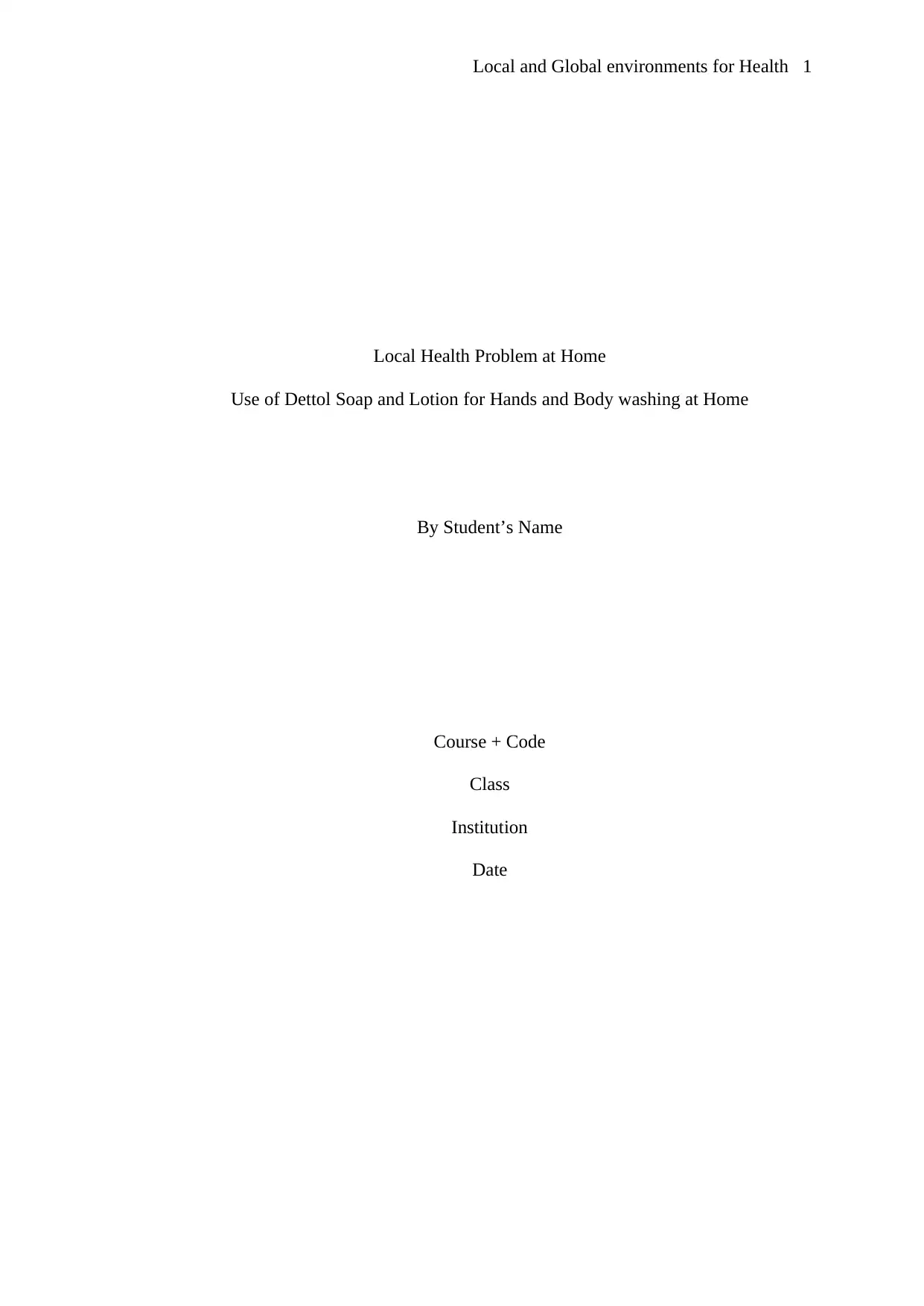
Local and Global environments for Health 1
Local Health Problem at Home
Use of Dettol Soap and Lotion for Hands and Body washing at Home
By Student’s Name
Course + Code
Class
Institution
Date
Local Health Problem at Home
Use of Dettol Soap and Lotion for Hands and Body washing at Home
By Student’s Name
Course + Code
Class
Institution
Date
Paraphrase This Document
Need a fresh take? Get an instant paraphrase of this document with our AI Paraphraser
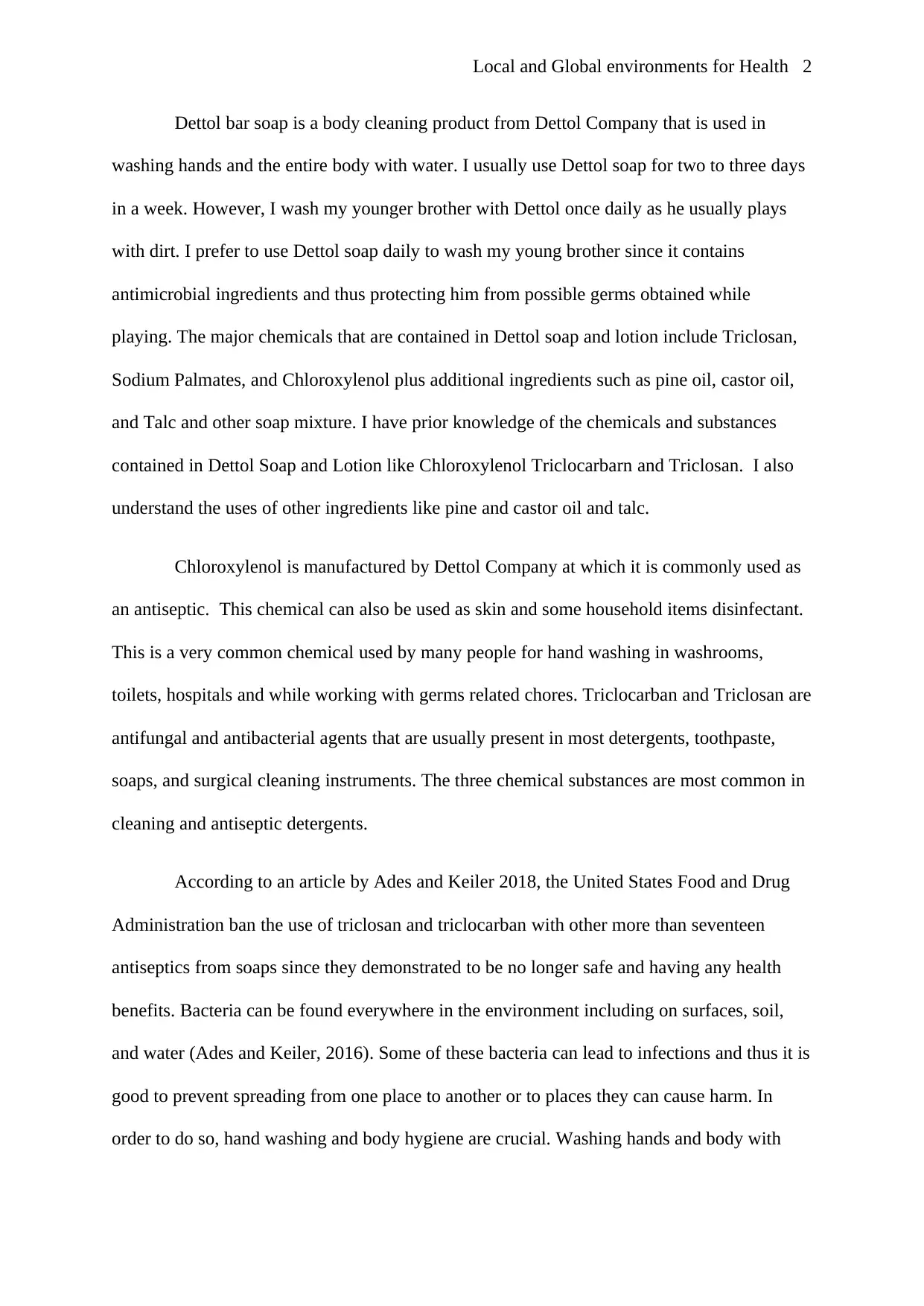
Local and Global environments for Health 2
Dettol bar soap is a body cleaning product from Dettol Company that is used in
washing hands and the entire body with water. I usually use Dettol soap for two to three days
in a week. However, I wash my younger brother with Dettol once daily as he usually plays
with dirt. I prefer to use Dettol soap daily to wash my young brother since it contains
antimicrobial ingredients and thus protecting him from possible germs obtained while
playing. The major chemicals that are contained in Dettol soap and lotion include Triclosan,
Sodium Palmates, and Chloroxylenol plus additional ingredients such as pine oil, castor oil,
and Talc and other soap mixture. I have prior knowledge of the chemicals and substances
contained in Dettol Soap and Lotion like Chloroxylenol Triclocarbarn and Triclosan. I also
understand the uses of other ingredients like pine and castor oil and talc.
Chloroxylenol is manufactured by Dettol Company at which it is commonly used as
an antiseptic. This chemical can also be used as skin and some household items disinfectant.
This is a very common chemical used by many people for hand washing in washrooms,
toilets, hospitals and while working with germs related chores. Triclocarban and Triclosan are
antifungal and antibacterial agents that are usually present in most detergents, toothpaste,
soaps, and surgical cleaning instruments. The three chemical substances are most common in
cleaning and antiseptic detergents.
According to an article by Ades and Keiler 2018, the United States Food and Drug
Administration ban the use of triclosan and triclocarban with other more than seventeen
antiseptics from soaps since they demonstrated to be no longer safe and having any health
benefits. Bacteria can be found everywhere in the environment including on surfaces, soil,
and water (Ades and Keiler, 2016). Some of these bacteria can lead to infections and thus it is
good to prevent spreading from one place to another or to places they can cause harm. In
order to do so, hand washing and body hygiene are crucial. Washing hands and body with
Dettol bar soap is a body cleaning product from Dettol Company that is used in
washing hands and the entire body with water. I usually use Dettol soap for two to three days
in a week. However, I wash my younger brother with Dettol once daily as he usually plays
with dirt. I prefer to use Dettol soap daily to wash my young brother since it contains
antimicrobial ingredients and thus protecting him from possible germs obtained while
playing. The major chemicals that are contained in Dettol soap and lotion include Triclosan,
Sodium Palmates, and Chloroxylenol plus additional ingredients such as pine oil, castor oil,
and Talc and other soap mixture. I have prior knowledge of the chemicals and substances
contained in Dettol Soap and Lotion like Chloroxylenol Triclocarbarn and Triclosan. I also
understand the uses of other ingredients like pine and castor oil and talc.
Chloroxylenol is manufactured by Dettol Company at which it is commonly used as
an antiseptic. This chemical can also be used as skin and some household items disinfectant.
This is a very common chemical used by many people for hand washing in washrooms,
toilets, hospitals and while working with germs related chores. Triclocarban and Triclosan are
antifungal and antibacterial agents that are usually present in most detergents, toothpaste,
soaps, and surgical cleaning instruments. The three chemical substances are most common in
cleaning and antiseptic detergents.
According to an article by Ades and Keiler 2018, the United States Food and Drug
Administration ban the use of triclosan and triclocarban with other more than seventeen
antiseptics from soaps since they demonstrated to be no longer safe and having any health
benefits. Bacteria can be found everywhere in the environment including on surfaces, soil,
and water (Ades and Keiler, 2016). Some of these bacteria can lead to infections and thus it is
good to prevent spreading from one place to another or to places they can cause harm. In
order to do so, hand washing and body hygiene are crucial. Washing hands and body with
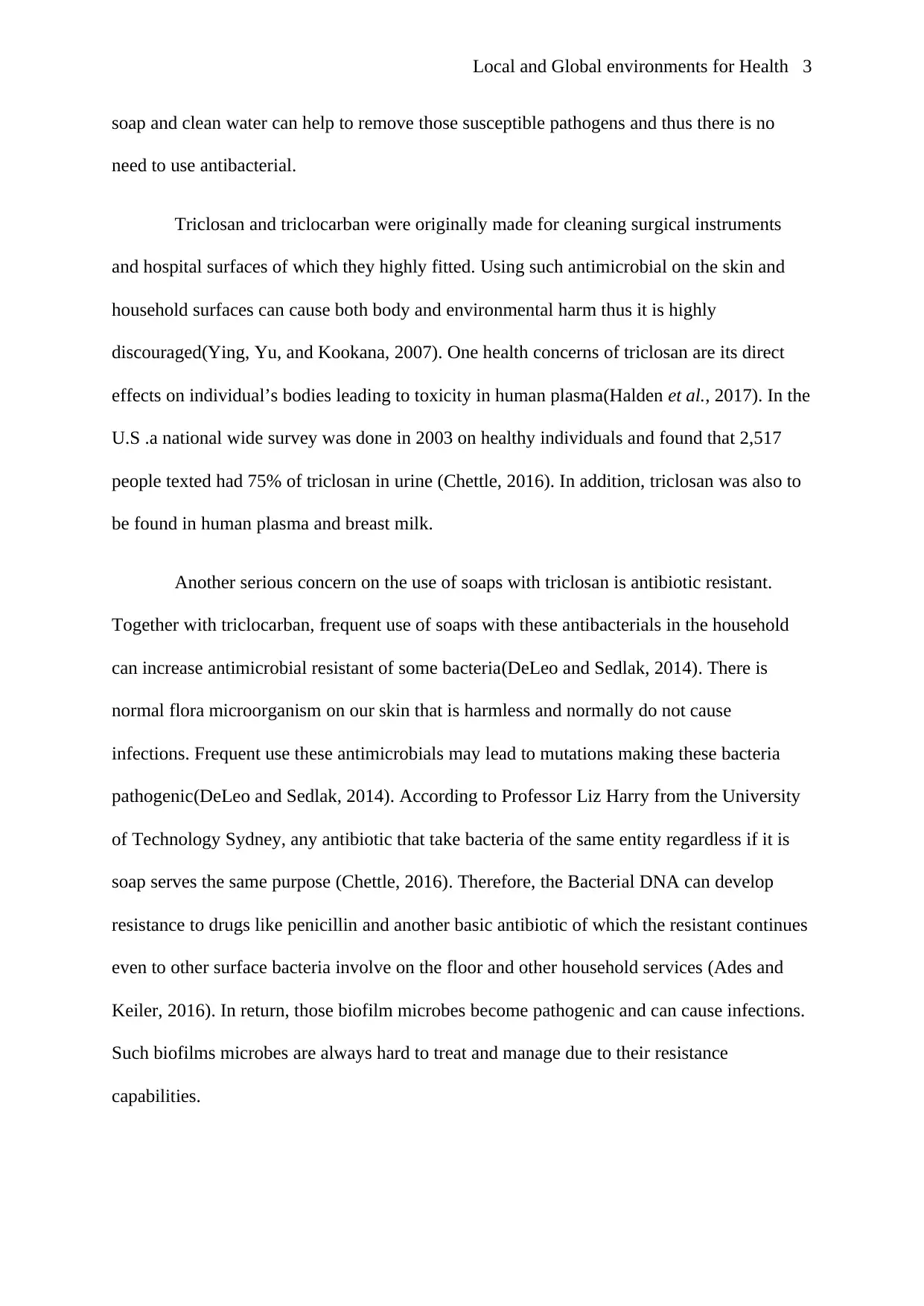
Local and Global environments for Health 3
soap and clean water can help to remove those susceptible pathogens and thus there is no
need to use antibacterial.
Triclosan and triclocarban were originally made for cleaning surgical instruments
and hospital surfaces of which they highly fitted. Using such antimicrobial on the skin and
household surfaces can cause both body and environmental harm thus it is highly
discouraged(Ying, Yu, and Kookana, 2007). One health concerns of triclosan are its direct
effects on individual’s bodies leading to toxicity in human plasma(Halden et al., 2017). In the
U.S .a national wide survey was done in 2003 on healthy individuals and found that 2,517
people texted had 75% of triclosan in urine (Chettle, 2016). In addition, triclosan was also to
be found in human plasma and breast milk.
Another serious concern on the use of soaps with triclosan is antibiotic resistant.
Together with triclocarban, frequent use of soaps with these antibacterials in the household
can increase antimicrobial resistant of some bacteria(DeLeo and Sedlak, 2014). There is
normal flora microorganism on our skin that is harmless and normally do not cause
infections. Frequent use these antimicrobials may lead to mutations making these bacteria
pathogenic(DeLeo and Sedlak, 2014). According to Professor Liz Harry from the University
of Technology Sydney, any antibiotic that take bacteria of the same entity regardless if it is
soap serves the same purpose (Chettle, 2016). Therefore, the Bacterial DNA can develop
resistance to drugs like penicillin and another basic antibiotic of which the resistant continues
even to other surface bacteria involve on the floor and other household services (Ades and
Keiler, 2016). In return, those biofilm microbes become pathogenic and can cause infections.
Such biofilms microbes are always hard to treat and manage due to their resistance
capabilities.
soap and clean water can help to remove those susceptible pathogens and thus there is no
need to use antibacterial.
Triclosan and triclocarban were originally made for cleaning surgical instruments
and hospital surfaces of which they highly fitted. Using such antimicrobial on the skin and
household surfaces can cause both body and environmental harm thus it is highly
discouraged(Ying, Yu, and Kookana, 2007). One health concerns of triclosan are its direct
effects on individual’s bodies leading to toxicity in human plasma(Halden et al., 2017). In the
U.S .a national wide survey was done in 2003 on healthy individuals and found that 2,517
people texted had 75% of triclosan in urine (Chettle, 2016). In addition, triclosan was also to
be found in human plasma and breast milk.
Another serious concern on the use of soaps with triclosan is antibiotic resistant.
Together with triclocarban, frequent use of soaps with these antibacterials in the household
can increase antimicrobial resistant of some bacteria(DeLeo and Sedlak, 2014). There is
normal flora microorganism on our skin that is harmless and normally do not cause
infections. Frequent use these antimicrobials may lead to mutations making these bacteria
pathogenic(DeLeo and Sedlak, 2014). According to Professor Liz Harry from the University
of Technology Sydney, any antibiotic that take bacteria of the same entity regardless if it is
soap serves the same purpose (Chettle, 2016). Therefore, the Bacterial DNA can develop
resistance to drugs like penicillin and another basic antibiotic of which the resistant continues
even to other surface bacteria involve on the floor and other household services (Ades and
Keiler, 2016). In return, those biofilm microbes become pathogenic and can cause infections.
Such biofilms microbes are always hard to treat and manage due to their resistance
capabilities.
⊘ This is a preview!⊘
Do you want full access?
Subscribe today to unlock all pages.

Trusted by 1+ million students worldwide
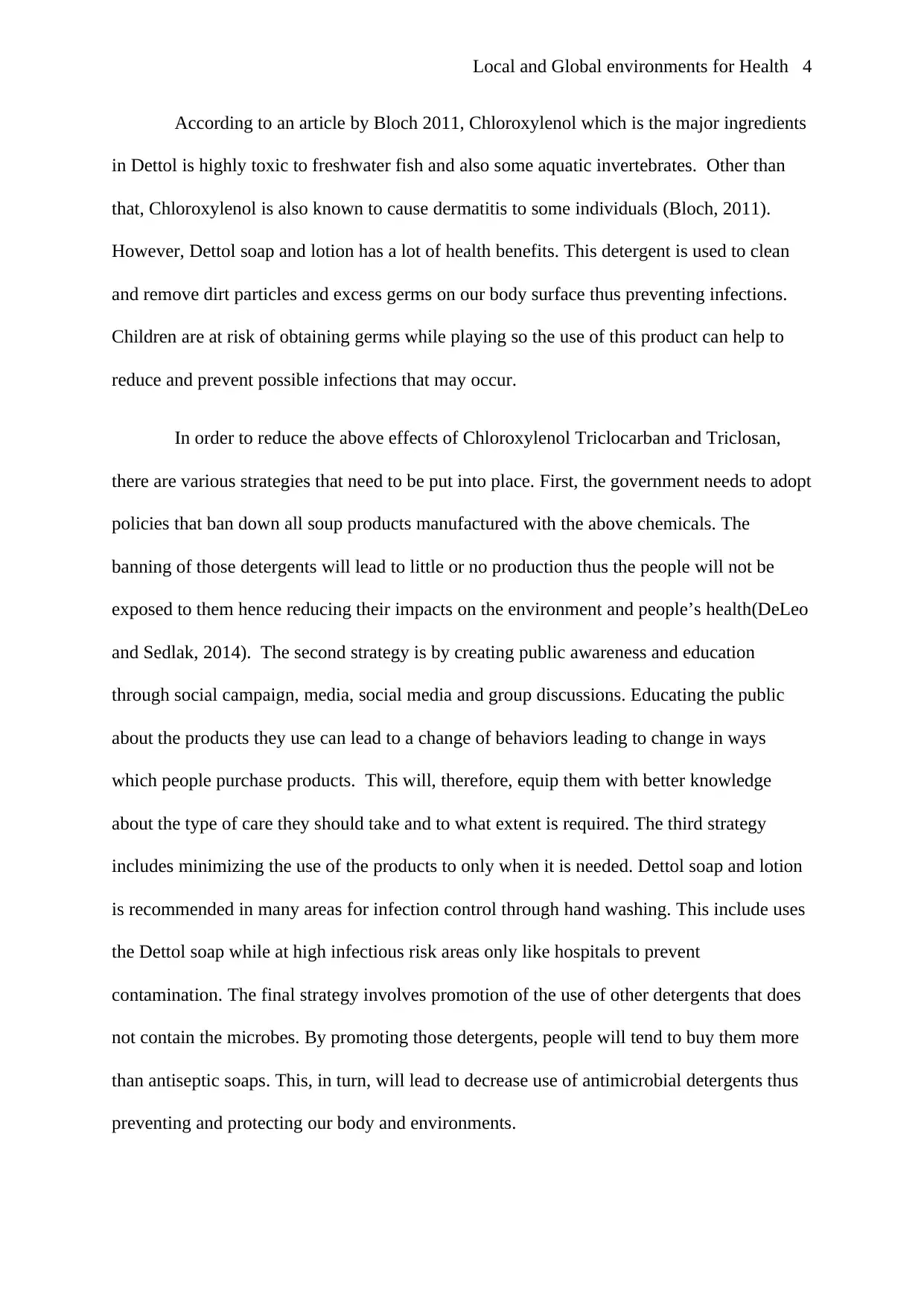
Local and Global environments for Health 4
According to an article by Bloch 2011, Chloroxylenol which is the major ingredients
in Dettol is highly toxic to freshwater fish and also some aquatic invertebrates. Other than
that, Chloroxylenol is also known to cause dermatitis to some individuals (Bloch, 2011).
However, Dettol soap and lotion has a lot of health benefits. This detergent is used to clean
and remove dirt particles and excess germs on our body surface thus preventing infections.
Children are at risk of obtaining germs while playing so the use of this product can help to
reduce and prevent possible infections that may occur.
In order to reduce the above effects of Chloroxylenol Triclocarban and Triclosan,
there are various strategies that need to be put into place. First, the government needs to adopt
policies that ban down all soup products manufactured with the above chemicals. The
banning of those detergents will lead to little or no production thus the people will not be
exposed to them hence reducing their impacts on the environment and people’s health(DeLeo
and Sedlak, 2014). The second strategy is by creating public awareness and education
through social campaign, media, social media and group discussions. Educating the public
about the products they use can lead to a change of behaviors leading to change in ways
which people purchase products. This will, therefore, equip them with better knowledge
about the type of care they should take and to what extent is required. The third strategy
includes minimizing the use of the products to only when it is needed. Dettol soap and lotion
is recommended in many areas for infection control through hand washing. This include uses
the Dettol soap while at high infectious risk areas only like hospitals to prevent
contamination. The final strategy involves promotion of the use of other detergents that does
not contain the microbes. By promoting those detergents, people will tend to buy them more
than antiseptic soaps. This, in turn, will lead to decrease use of antimicrobial detergents thus
preventing and protecting our body and environments.
According to an article by Bloch 2011, Chloroxylenol which is the major ingredients
in Dettol is highly toxic to freshwater fish and also some aquatic invertebrates. Other than
that, Chloroxylenol is also known to cause dermatitis to some individuals (Bloch, 2011).
However, Dettol soap and lotion has a lot of health benefits. This detergent is used to clean
and remove dirt particles and excess germs on our body surface thus preventing infections.
Children are at risk of obtaining germs while playing so the use of this product can help to
reduce and prevent possible infections that may occur.
In order to reduce the above effects of Chloroxylenol Triclocarban and Triclosan,
there are various strategies that need to be put into place. First, the government needs to adopt
policies that ban down all soup products manufactured with the above chemicals. The
banning of those detergents will lead to little or no production thus the people will not be
exposed to them hence reducing their impacts on the environment and people’s health(DeLeo
and Sedlak, 2014). The second strategy is by creating public awareness and education
through social campaign, media, social media and group discussions. Educating the public
about the products they use can lead to a change of behaviors leading to change in ways
which people purchase products. This will, therefore, equip them with better knowledge
about the type of care they should take and to what extent is required. The third strategy
includes minimizing the use of the products to only when it is needed. Dettol soap and lotion
is recommended in many areas for infection control through hand washing. This include uses
the Dettol soap while at high infectious risk areas only like hospitals to prevent
contamination. The final strategy involves promotion of the use of other detergents that does
not contain the microbes. By promoting those detergents, people will tend to buy them more
than antiseptic soaps. This, in turn, will lead to decrease use of antimicrobial detergents thus
preventing and protecting our body and environments.
Paraphrase This Document
Need a fresh take? Get an instant paraphrase of this document with our AI Paraphraser
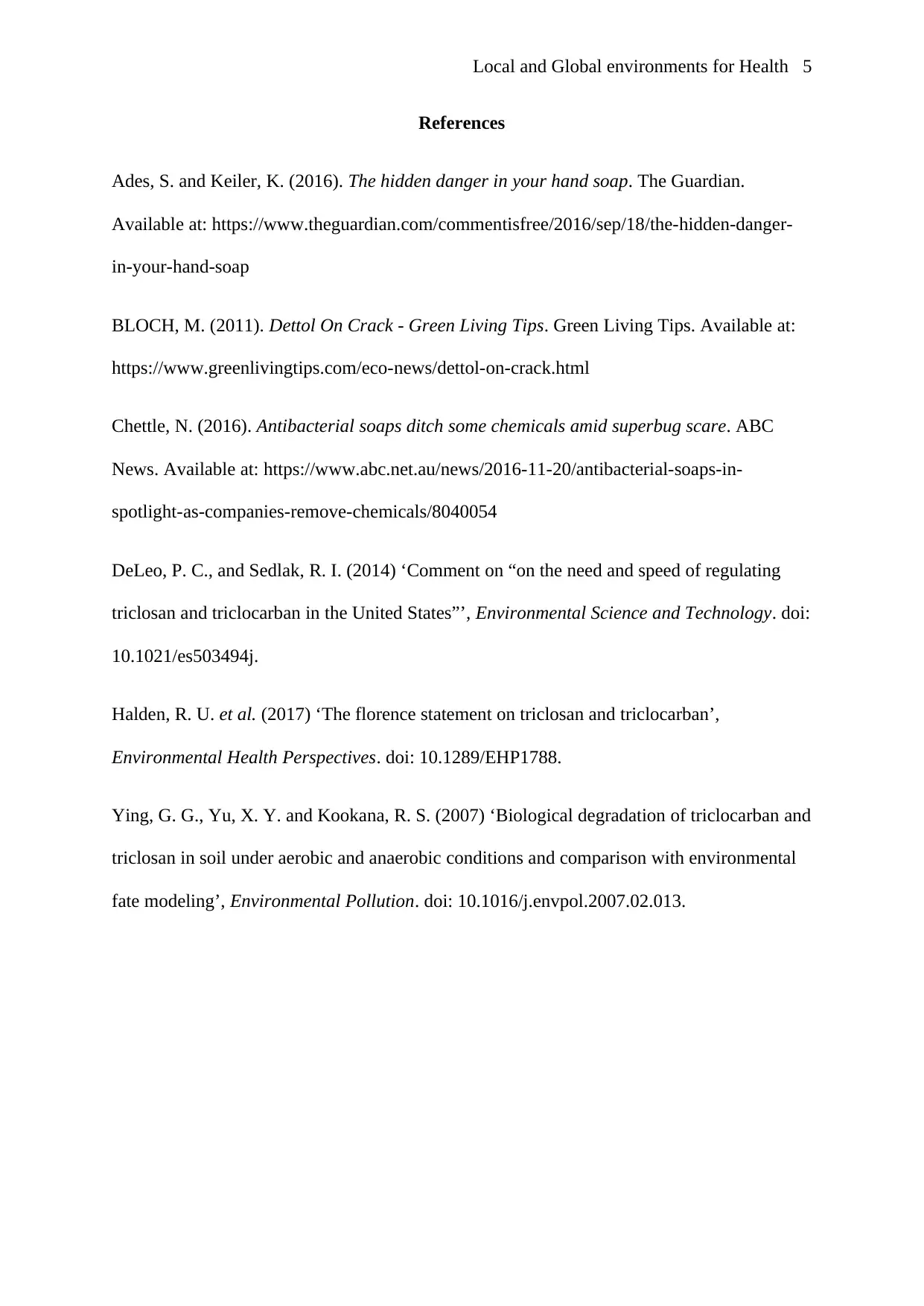
Local and Global environments for Health 5
References
Ades, S. and Keiler, K. (2016). The hidden danger in your hand soap. The Guardian.
Available at: https://www.theguardian.com/commentisfree/2016/sep/18/the-hidden-danger-
in-your-hand-soap
BLOCH, M. (2011). Dettol On Crack - Green Living Tips. Green Living Tips. Available at:
https://www.greenlivingtips.com/eco-news/dettol-on-crack.html
Chettle, N. (2016). Antibacterial soaps ditch some chemicals amid superbug scare. ABC
News. Available at: https://www.abc.net.au/news/2016-11-20/antibacterial-soaps-in-
spotlight-as-companies-remove-chemicals/8040054
DeLeo, P. C., and Sedlak, R. I. (2014) ‘Comment on “on the need and speed of regulating
triclosan and triclocarban in the United States”’, Environmental Science and Technology. doi:
10.1021/es503494j.
Halden, R. U. et al. (2017) ‘The florence statement on triclosan and triclocarban’,
Environmental Health Perspectives. doi: 10.1289/EHP1788.
Ying, G. G., Yu, X. Y. and Kookana, R. S. (2007) ‘Biological degradation of triclocarban and
triclosan in soil under aerobic and anaerobic conditions and comparison with environmental
fate modeling’, Environmental Pollution. doi: 10.1016/j.envpol.2007.02.013.
References
Ades, S. and Keiler, K. (2016). The hidden danger in your hand soap. The Guardian.
Available at: https://www.theguardian.com/commentisfree/2016/sep/18/the-hidden-danger-
in-your-hand-soap
BLOCH, M. (2011). Dettol On Crack - Green Living Tips. Green Living Tips. Available at:
https://www.greenlivingtips.com/eco-news/dettol-on-crack.html
Chettle, N. (2016). Antibacterial soaps ditch some chemicals amid superbug scare. ABC
News. Available at: https://www.abc.net.au/news/2016-11-20/antibacterial-soaps-in-
spotlight-as-companies-remove-chemicals/8040054
DeLeo, P. C., and Sedlak, R. I. (2014) ‘Comment on “on the need and speed of regulating
triclosan and triclocarban in the United States”’, Environmental Science and Technology. doi:
10.1021/es503494j.
Halden, R. U. et al. (2017) ‘The florence statement on triclosan and triclocarban’,
Environmental Health Perspectives. doi: 10.1289/EHP1788.
Ying, G. G., Yu, X. Y. and Kookana, R. S. (2007) ‘Biological degradation of triclocarban and
triclosan in soil under aerobic and anaerobic conditions and comparison with environmental
fate modeling’, Environmental Pollution. doi: 10.1016/j.envpol.2007.02.013.
1 out of 5
Related Documents
Your All-in-One AI-Powered Toolkit for Academic Success.
+13062052269
info@desklib.com
Available 24*7 on WhatsApp / Email
![[object Object]](/_next/static/media/star-bottom.7253800d.svg)
Unlock your academic potential
Copyright © 2020–2025 A2Z Services. All Rights Reserved. Developed and managed by ZUCOL.



